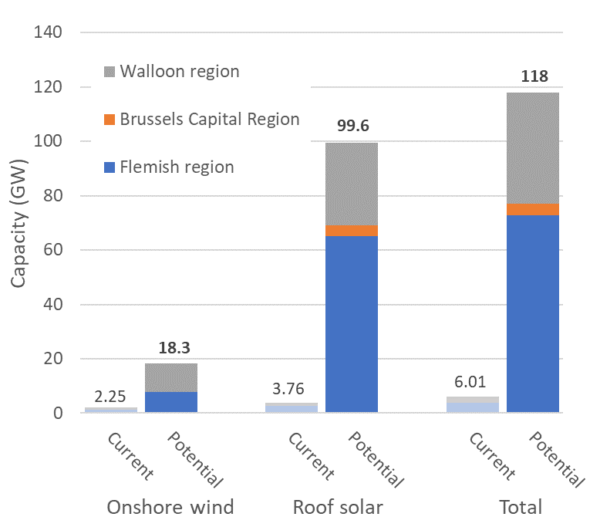EnergyVille, a joint venture between the Belgian research entities KU Leuven, VITO, imec and UHasselt, has estimated Belgium's technical potential of rooftop solar and onshore wind and has found these two sources alone may reach an aggregate installed power of 118 GW, with the largest portion – 99.6 GW – being secured by solar arrays, with a 50/50 split between residential and commercial-industrial installations.
The institutes' experts identified all suitable locations for both technologies and combined these geographical data with technical parameters and meteorological data taken in 2017. “Reported new capacities in the study assume covering the available roof space with a 226 Wp per m² PV module (SPR-MAX3-400) at [a] specified tilt and orientation per building type,” EnergyVille experts specified. “The availability of PV varies between 930 [and] 1,060 full load hours in Belgium, or a potential additional energy production of approximately 99.3 TWh per year.”
Of the three Belgian macro-regions, Flemish-speaking Flanders is the one with the largest solar potential for rooftop systems, at around 65 GW, followed by French-speaking Wallonia, with around 30 GW, and the Brussels metropolitan region, with around 4.2 GW. At the end of 2020, Belgium had a total cumulative PV capacity of over 6 GW and almost all of this power is represented by residential and commercial PV systems, with only a few ground-mounted solar parks having been constructed in the country. Its legislation, on the other hand, is extremely hostile to utility scale solar and the vast majority of the PV installations in the country do not exceed 10 kW in size.

The model used considered current policy constraints on available space and calculated the generation potential according to demand and grid capacity and flexibility. According to the research's findings, the potential for commercial and industrial projects is highest in Flanders and is concentrated around industrial districts along highways and navigable waterways, like the southern West-Flanders and the Meuse-Sambre axis, rather than in urban centers.
The research institute specified that potential additions of ground-mounted and building-integrated photovoltaic (BIPV) installations were not included, which shows the country may have a larger technical potential for the solar technology than that estimated by its analysis. “Unfortunately, no clear policy guidelines exist to prioritize ground-mounted PV over other land uses (water bodies, agriculture or industrial complexes) nor to evaluate in a spatially explicit manner the technical potential for BIPV in a reliable way, and therefore [they] are not yet assessed in this study,” its experts concluded.